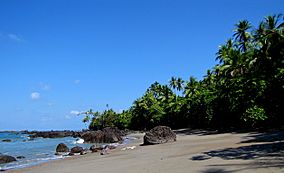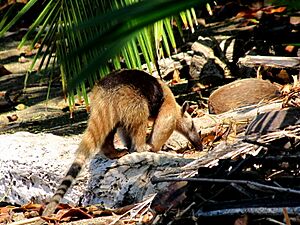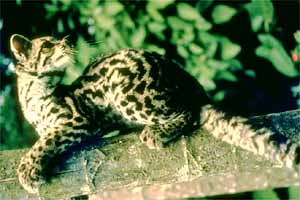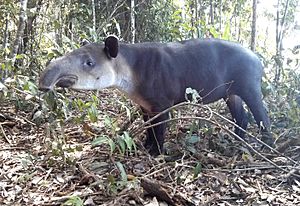Corcovado National Park facts for kids
Quick facts for kids Corcovado National Park |
|
|---|---|
|
IUCN Category II (National Park)
|
|

Corcovado National Park
|
|
| Lua error in Module:Location_map at line 420: attempt to index field 'wikibase' (a nil value). | |
| Location | Osa Peninsula, Costa Rica |
| Area | 424 km2 (164 sq mi) |
| Established | October 24, 1975 |
| Governing body | National System of Conservation Areas (SINAC) |
Corcovado National Park (which means Parque Nacional Corcovado in Spanish) is a special protected area in Costa Rica. It is located on the Osa Peninsula in the southwestern part of the country. This park was created on October 24, 1975.
Corcovado National Park covers about 424 square kilometers (164 square miles). It is the biggest park in Costa Rica and protects about one-third of the Osa Peninsula. Many people think it is the most amazing park in Costa Rica.
National Geographic magazine has even called Corcovado "the most biologically intense place on Earth." This means it has an incredible variety of plants and animals. It is a very popular spot for scientists who study tropical nature. Visitors can also see lots of amazing wildlife here.
The park protects the largest primary forest on the Pacific coast of the Americas. It also has one of the last big areas of tropical rainforests in the world. These lowland rainforests are very important because they have so many different kinds of plants and animals. Protecting this park helps keep these special habitats safe.
Contents
Amazing Animals of Corcovado
Corcovado National Park is home to many rare and endangered animals. It is a safe place for them to live.

You can find a good number of Baird's tapirs here. These are large, pig-like animals. The park also has a small group of the very rare harpy eagle, which is one of the biggest and most powerful eagles in the world.
The rivers and lagoons in the park are home to American crocodiles and spectacled caiman. You might even spot bull sharks in some river mouths. Corcovado is one of the last places in Central America where jaguars live. Other wild cats like ocelots, margays, jaguarundis, and pumas also live here.
All four types of monkeys found in Costa Rica live in Corcovado. These include the endangered Central American squirrel monkey, white-faced capuchins, mantled howlers, and Geoffroy's spider monkeys. Other mammals you might see are two-toed and three-toed sloths. There are also collared peccarys, northern tamanduas, and silky anteaters.
The park also has colorful poison dart frogs and several kinds of snakes. Some of these snakes are venomous, like the fer-de-lance and bushmaster.
Rich Plant Life
The park's many animals thrive because of the wide variety of plants. Corcovado has at least 13 different types of plant life. These include montane forests, cloud forests, and mangroves. There are over 500 types of trees here.
Corcovado is also special because it is part of a natural "land bridge" between North and South America. This means many different plants and animals have traveled through this area over time. This has made the park very rich in biodiversity.
Ocean Life Near the Park
The waters near Corcovado National Park are calm and full of life. The Cano Island Biological Reserve is one of the important marine areas nearby.
The coasts, like at Drake Bay, are places where humpback whales come to spend the winter and have their babies. Other whales, like Bryde's whales, also travel through this area. You can often see Dolphins, such as spinner and rough-toothed dolphins. Larger cetaceans like false killer whales and killer whales are also seen here at certain times of the year.
Manatees are gentle marine mammals that have been hunted in Costa Rica in the past. Now, there are only a few left. You might sometimes see them in areas like Manzanillo Beach.
Visiting Corcovado National Park
Corcovado National Park is open to visitors. You can go for a day trip or stay overnight. Since February 1, 2014, all visitors must have a certified guide with them. As of August 2014, the entrance fee for non-Costa Rican residents is $15 per person per day.
If you want to stay overnight, you can make reservations in Puerto Jimenez on the east side of the peninsula. You can camp or stay in bunk beds at one of the ranger stations. If you want meals, you should book about a week ahead. Researchers get first choice for rooms, but there is usually space for campers.
You can start your visit from Puerto Jimenez or Drake Bay. These are the main entry points. There are two main paths in the park: one along the coast and one inland. There are four ranger stations where you can stay overnight. Three are at the park entrances, and one is where the two paths meet. Some parts of the park might be closed during the wet months (July to November).
Coastal Path Challenges
On the coastal path, you will need to cross several rivers. These rivers can be dangerous if you cross them at high tide or if you are not used to this kind of environment. The Rio Sirena is often considered the most dangerous crossing. This is because it flows into the large Laguna Corcovado.
Bull sharks can be found in the Rio Sirena, especially near the river mouth at high tide. American crocodiles are also in the river, but most are small. Spectacled caiman are found further upriver and in Laguna Corcovado. The Rio Claro, about 40 minutes south of Rio Sirena, is thought to be safer. Small crocodiles and caiman are also there, but in smaller numbers. Bull sharks are not believed to be in the Rio Claro. The biggest danger when crossing any river is the strong current.
The Rio Madrigal, just north of the park entrance, is much smaller. It might be home to spectacled caiman. The Jaguar is a large and beautiful wild cat. They are usually shy and not interested in humans. They can hunt large animals like Tapirs, but they tend to stay away from people.

You are likely to see many animals on the coastal path. You can see scarlet macaws flying overhead and hermit crabs on the beach. Pelicans fish in the sea. Inland, you might spot spider monkeys, tamandua anteaters, pumas, white-faced capuchin monkeys, lineated woodpeckers, and coatis. With luck, you might even see a tapir, even though they are active at night.
Corcovado is also a good place to see the red-eyed tree frog, the glass frog (which has transparent skin), and bright poison-arrow frogs. From Estación Sirena, you can take short night walks into the forest. You have a good chance of seeing a tapir. They are impressive but harmless if you leave them alone. You are very likely to see jaguar tracks, but it is rare to see the actual cat. The most common animal in the park is the white-nosed coati. You will probably see dozens of them on the beach hike between La Leona and Sirena. They dig for and eat moon crabs.
The inland path to Estación Los Patos goes through younger forest for much of the way. It is still a beautiful walk with more variety. It is also easier to walk, with no sand and no big river crossings.
Other animals in the park include Central American squirrel monkeys, mantled howler monkeys, both two-toed and three-toed sloths, agoutis, giant anteaters, great curassows, black hawks, spectacled owls, and hummingbirds. There are also 220 types of butterflies, golden orb spiders (who make huge webs), otters, and raccoons. Four types of sea turtles (green, Pacific ridley, hawksbill, and leatherback) lay their eggs on the beaches.
How the Park Was Created
Because the Osa Peninsula was so remote, logging only started there in the 1960s. By 1975, there were plans for a very large international logging project. Scientists asked President Daniel Oduber to protect the area. He agreed and made it a National Park. For this, he received an award called the Albert Schweitzer Award.
Gold miners who were already in the area were allowed to stay at first. But by 1986, their numbers grew to about 1,000 people. They also hunted the wildlife. So, it was decided to move them out of the park. However, some illegal mining still happens today, using methods that can harm the environment. Illegal logging is not common, but the trees that are cut down are very important for the ecosystem.
More tourism has led to more people in the park. This could be a problem for the park's larger animals in the long run. To help with this, many groups are working together to protect the park.
Images for kids
-
Pantropical spotted dolphins off Osa Peninsula
See also
 In Spanish: Parque nacional Corcovado (Costa Rica) para niños
In Spanish: Parque nacional Corcovado (Costa Rica) para niños




